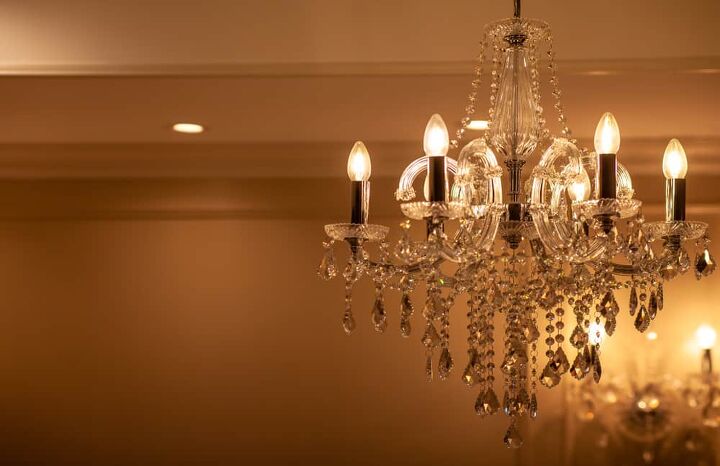15 Types Of Chandeliers Explained (with Photos)

I’m….gonna swing…on the chandelier…and probably break it! Okay, now that we have gotten that goofiness out of the way, it’s time to discuss chandeliers. Once reserved for the wealthy, it’s increasingly common to see homes of the middle class equipped with them. If you want one, you need to be able to say exactly what you want. Knowing the types of chandeliers helps, but there’s more to it than you think.
You have plenty of chandeliers that you can choose from, each with its own style and uses. While new chandeliers are always being made, these below are famous for being popular options:
- Empire
- Antler
- Sputnik
- Bowl
- Globe
- Crystal
- Paper
- Drum
- Waterfall
- Shaded
- Mini-Chandelier
- Caged
- Candle
- Tiered
- Ring
There are so many gorgeous chandeliers you can choose. It’s good to know which types will suit your home and what you want to grab before you take a trip to the store.
The Many Types Of Chandelier Styles
While many of our articles can be pretty short, this one isn’t going to be. There are a TON of styles we can talk about, including some rather obscure ones. We’re going to talk about as many as we can before we fall asleep at the keyboard, okay? Let’s go!
Empire Chandeliers
Empire chandeliers are known for having a large bell shape, usually covered with glass beads. A good example is the one in the photo above. The overall look is meant to harken back to the days of royalty and palaces. In fact, you might actually see these in actual castles.
These chandeliers are very formal, regal, and pricey. They tend to do best in larger homes with more traditional decorations. If you’re okay with a lot of maintenance when it comes to cleaning, you’ll probably be okay with an empire chandelier. It’s a light fixture fit for a king!
Cage Chandeliers
Love the idea of having some geometric flair to your home, but don’t quite know how to make it happen? Check out cage chandeliers. As the name suggests, cage chandeliers involve hanging lights in geometric cages. These can be made of metal, acrylic, or wood. They’re elegant, sleek, and made for modern areas that have an urban feel. What’s not to love?
Cage chandeliers are great for people who want to have unique materials involved in the making of their chandeliers. Sometimes, it can turn into a major fashion statement.
Crystal Chandeliers
Nothing glitters quite as well as crystal, and chandelier makers know it. Crystal chandeliers involve stylized, expertly cut pieces of crystal that drape throughout the chandelier. In many cases, the “candle holders” also have crystal accents. The idea behind this type of design is best explained as ramping up the decadence. Due to how bold they are, these are best left to larger rooms with a formal ambiance.
Crystal chandeliers are a classic because they’re elegant. They ooze wealth and make any room look a little more upscale.
Waterfall Chandeliers
Hypermodern and effortlessly elegant, waterfall chandeliers get their name from glass (or crystal) beads that are arranged in a way that makes it appear as if the chandelier is dripping waterfall. The drippy, watery look of the bead arrangements works well with both modern and more traditional home layouts. Since waterfall chandeliers can come in both large and small sizes, chances are high that you’ll find one that works with your room size.
Waterfall chandeliers are pointedly modern. The one issue you might have is that these light fixtures can be a little hard to clean.
Traditional Chandeliers
Traditional chandeliers are what most people will see in homes across the country. They are categorized by multiple lights, all in a ring, all in a single row. They are contemporary yet classic, often with a slightly country air. If you are not sure what style you want to have in your room, going for a traditional chandelier is a good idea. They can work with almost every type of decor you can get, and are good with both large and small rooms.
Traditional chandeliers can have shades, or they can have their lights out in the open. Both can be traditional, since this is more of a structural type than anything else. Since it’s a structural type, they also can be almost any type of style.
Candelabra Chandeliers
Candelabra chandeliers are exactly what you think they are. They are chandeliers that are meant to channel the old-world look of a chandelier with candles. Obviously, today the candles are electric. However, the look still remains popular. They’re particularly good for rooms that have a European, Mediterranean, or deeply traditional look. Victorian homes also work pretty darn well with them.
If you have a country home, this is a good pick too. To get the most of it, choose candlelight bulbs with a realistic look.
Bowl Chandeliers
Bowl chandeliers are pretty easy to spot. They have the light encased in a bowl-shaped casing. Sometimes the bowl “sits” right-side up acting as a diffuser for the light, other times, the bowl is upside-down (like in the picture) and acts as a lampshade. These are pretty classic options for kitchens, modern living rooms, as well as dining rooms.
Want a chandelier that’s easier to work with? This is it. Fans of clean looks and diffused, softer lights will want to check these out as soon as possible.
Shaded Chandeliers
Traditionally, chandeliers had an open build. In other words, their lightbulbs (or candles, back in the day) were out in the open with nothing covering them. That look is still the most popular, but that doesn’t mean you have to keep your bulbs open. Shaded chandeliers have miniature lampshades over every single bulb that is a part of the chandelier.
Adding shade to the chandelier’s lights will help soften and diffuse the light. This gives you a dimmer look that’s easier on the eyes and enhances the mood.
Tiered Chandeliers
In a traditional chandelier, all the lights are on a single level. Tiered chandeliers are exactly what they sound like: they’re chandeliers with multiple levels (or tiers) of lights. These tend to be larger and bulkier than regular chandeliers, not to mention more ornate. If you are looking to go big with your decor or have a larger room, this is a good choice for you to make.
Like traditional chandeliers, tiered chandeliers are a category that’s more about structure than style. So, you can find them in virtually any “flavor” of chandelier.
Sputnik Chandelier
Sputnik chandeliers are also known as “starburst chandeliers.” The reason why is obvious: these look like giant bursts of metal. Originally made in the 1950s, many of the chandeliers in this category are holdovers from the Atomic Age. With that said, they’re excellent for any industrial or midcentury modern home. I mean, look at them. They’re amazing.
Sputniks are a little tough to clean, but there’s great news here. They are incredibly durable and can handle almost any tumble. That’s something crystal chandeliers can’t do.
Circle Chandeliers
As the name suggests, this spacey-looking chandelier style features light-up LED circles that are hung from the ceiling. Sometimes, it’s a single ring. Other times, as the picture above shows, it can be multiple rings that are elegantly hung together at different angles. These offer a crisp and clean look that works well with almost any modern theme.
While these are pretty durable, they also tend to be fairly hard to find. If you do find one, set aside extra cash. These can be surprisingly pricey!
Globe Chandeliers
If you’ve walked to a new hipster bar, then you probably saw at least one of these. Globe chandeliers are hanging lights that are totally encased in a glass ball—or encased in a bunch of wires or ornaments that are in the shape of a ball. Because these round chandeliers can range from the stark to the decadent, they can work in tons of environments.
Though replacing the bulbs can be a chore, these are super trendy and easy to clean. Industrial fans are going to adore this type of chandelier, especially since it’s not what most people think about when they hear the word “chandelier.”
Paper Chandelier
This is one of the few chandelier styles that actually is a misnomer. These chandeliers are not made out of paper, but rather a thin paper-like plastic that keeps its shape. They’re pretty hard to first put together (as most of these will require that!) but once you have them, it’s hard to hate the soft yet bright light they give off.
The majority of these light fixtures have very unique, modern looks and shapes. It’s very unlikely that you’ll ever see two identical paper lamps unless you’re at an IKEA.
Antler Chandeliers
Do you have a deep love of all things rustic? Perhaps, it’s time for a chandelier that looks like it belongs to a 90s Abercrombie and Fitch. Antler chandeliers made from real or fake deer antlers. The “candles” are usually held inside the crooks of the antlers, giving it a deeply woodsy ambiance that is both natural and a little bit extra.
Anyone who owns a cabin needs to consider getting one of these. They look so perfect when surrounded by wood.
Mini-Chandeliers
Not all homes have the space for a full chandelier, especially if it’s two or more feet. Mini-chandeliers give people the opportunity to add the glamour of a full-size chandelier with a smaller build. These are chandeliers of any particular structure and material you choose but are far smaller than a typical chandelier. This means they’re usually under 1.5 feet in diameter.
If your home is super small, or you’re just not a fan of the “go big or go home” attitude of many chandelier makers, this is a good type to request. Much like with other broad genres of chandeliers, there’s a mini-chandelier for every style.
Drum Chandeliers
Though most shaded chandeliers have a single shade around each candle, drum chandeliers tend to encircle all of their lights in one large shade. Since these shades tend to be long, circular, and flat, they’re called drums. They are pretty popular among people who want to have a home that looks modern, but still keeps things looking homey.
Drum chandeliers are exceptionally versatile, especially if you’re the type of person who doesn’t want glaring lights or bare bulbs in a room. Like with other types of shaded chandeliers, the shade helps improve the mood of the room.
How Should You Choose A Chandelier?
There’s no single way to choose a chandelier. Everyone has their own ideas, and the truth is, most people naturally tend to gravitate to one style or another pretty quickly. If you aren’t sure what to look for, it’s best to keep the factors below in mind while you’re shopping:
- Style. The style and appearance of your chandelier is going to be one of the biggest factors, if not the biggest. You need to pick a chandelier that works well with the overall look of the room. Of course, you also need to find a chandelier that makes you go, “Ooh! I like that!” when you see it. If you don’t like the chandelier you’re not going to do well with it.
- Size. Your chandelier should have enough clearance to avoid anyone hitting their head. But, that’s not the only issue. To get a proportional chandelier, add the dimensions of the room together to get the ideal diameter of the chandelier. For example, a 12 foot by 15-foot room would be ideal for a chandelier that’s 27 inches in diameter.
- Luminescence. Some chandeliers will give off a light that’s way too bright for a room. Others will be a little too dim, even if you have a bright bulb. If at all possible, try to find a chandelier that has the right amount of light for your room.
- Maintenance. Some chandeliers are going to be harder to clean than others, and that’s no joke. If you’re going to be the one in charge of all the cleaning, it makes sense to go for an easy-to-clean choice.
How Much Do Chandeliers Cost?
The price of a chandelier can vary greatly depending on both the type and the size, plus materials. Most agree that the bottom rung of the price scale starts at $50 for a new chandelier, with the majority of chandeliers costing between $150 to $250 for a typical model.
Though it’s common enough to get a chandelier for a couple hundred bucks, it’s important to realize that some types tend to be more expensive than others. Here’s what to be aware of:
- Crystal chandeliers and sputnik chandeliers tend to be the most expensive of the bunch, with prices regularly going as high as $1,000 or more. Extremely large crystal chandeliers can become incredibly pricey, to the point that it might cost you a typical person’s mortgage.
- If you want something affordable, go for a drum chandelier or a paper chandelier. They are surprisingly affordable, though they often look far pricier. In most cases, shaded chandeliers are going to be the cheapest you can find.
- Custom-made chandeliers can easily run in excess of $5,000 or more. A quick walk through the streets of Manhattan will show you plenty of places where the price of a handmade chandelier runs into the thousands.
Can You Buy Used Chandeliers?
Chandeliers that are used are hard to come by, but it is doable. Assuming that the wiring is in good condition, there’s no reason why you shouldn’t give a used chandelier a chance. You can usually find chandeliers for sale on eBay and in antique shops near you. If you decide to get an antique chandelier, make sure to check the wiring is good to go.
While you can buy them used, the truth is that you might have longevity issues if you go this route. This is especially true with LED chandeliers that don’t involve replaceable bulbs. This is why we do not suggest getting a used LED chandelier unless you have a way to switch out the bulbs. You might end up with a dud!
How Long Do Chandeliers Last?
Well-maintained traditional chandeliers can last for well over 50 years, as long as you’re open to replacing the wiring from time to time. However, things change when it comes to LED chandeliers—especially if you can’t remove the bulb. Most LED chandeliers will last between 5 to 15 years before they need to be replaced.
It’s worth noting that improperly installed chandeliers (particularly bulb-free LED strips) can get prone to burnout extremely quickly. It’s not unheard-of for people to report having their chandeliers burn out in as little as one to two years post-installation. So, if you choose to get an LED chandelier, make a point of installing it well.
Related Questions
Are chandeliers officially considered to be fixtures?
Yes. Due to the fact that they have to be installed into the ceiling, most contractors and home inspectors will tell you that chandeliers are light fixtures according to both valuation and insurance writeups. This means that they can get special protections through homeowners’ insurance, especially if the chandelier in question is a highly notable model.If you just installed a very pricey chandelier, it’s important to mention this to your insurer, as you might be able to get extra protection for your fixture.
Can chandeliers get painted?
Yes and no. For the most part, chandeliers that are made out of metal, wood, plastic, and antler material should be totally safe to paint. In fact, many interior designers choose to paint their chandeliers to turn them into a style statement with a serious pop of color. Getting your chandelier painted can be fairly easy as long as you have the right paint.Though most chandeliers can be painted, some shouldn’t be. If you have a shaded chandelier, a crystal chandelier, or a chandelier that has paper as part of it, painting the chandelier can be a fire hazard. Should you decide to do this anyway, make sure that you don’t use bulbs prone to overheating and that the paint you use is appropriate for warmer temperatures.
Can chandelier heights be adjusted?
Of course, they can. It all depends on how you install it. It’s possible to hang a chandelier at the height you want. All you have to do is get the right cord for it, or fold the cord differently, or fasten the electric cord to the wall. It’s best to hire someone to do this if you don’t feel comfortable with it.
Related Guide

Ossiana Tepfenhart is an expert writer, focusing on interior design and general home tips. Writing is her life, and it's what she does best. Her interests include art and real estate investments.
More by Ossiana Tepfenhart











































